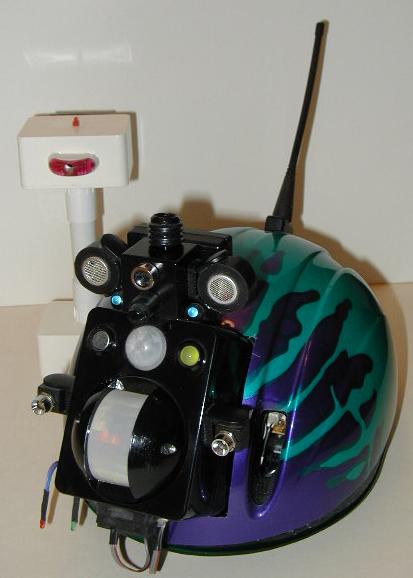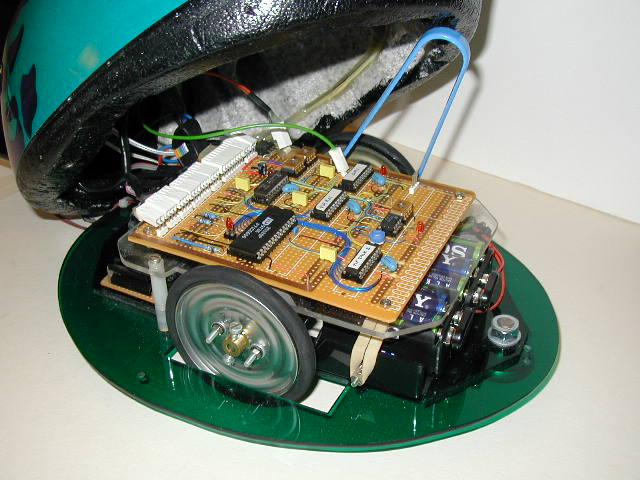
ELF (Electronic Life Form)
ELF is a concept cybernetic animal, which is the culmination of many years of research, the idea was to produce a cybernetic creature that is as close to a real life animal as possible. ELF can navigate its environment, feed and look after itself. It has a learning mechanism with emotion generating routines together with advanced sensors. In general it thinks and acts for itself (it decides what behaviours it enables depending on its power source status). As the animal evolves by itself, no two devices will act the same, each generating it's own personality over time. It's advanced sensory processors are capable of self-recognition, movement analysis (types of movement in view – this is achieved by an advanced intelligent PIR sensor), sound analysis (types of sound it is hearing), ultrasonic ranging, nest (docking charger) acquisition. Its body has multiple capacitive sensors built in. ELF uses nine PIC micro-controllers, It has subsumption architecture, mapping/route searching algorithms and utilises volumetric occupancy maps. Work commenced on ELF in 1996 and continued to 1999.

(Yes, that is a cyclist's helmet used as the creature's "Shell")
ELF functionality
1. Self recognition – ELF recognises itself in a mirror (only a mirror) – this generates very neat/cute reflexes.
2. Movement analysis – This is a PIR sensor whose output is processed by a PIC, This sensor detects patterns of movement directly in front of the animal, i.e. dancing etc. It can also distinguish which direction a human/animal approaches from (either left or right) it can also determine the difference between humans loitering in the background, people dancing and hand waving etc.
3. Sound analysis – This is a further sensor with it’s own PIC, it can determine the difference between music, talking (not speech recognition), hand claps, whistling and silence.
4. Ultrasonic ranging – sensor range is 150mm to 2m.
5. Nest (docking charger) sensor – This is an IR detector with narrow/restricted view, the nest tower emits wide angle pulsed IR. ELF tries to obtain a lock on the beacon by first going to the region were it should be found (via a volumetric map), then if this fails (nest moved) a search algorithm is activated.
6. Body capacitance sensors – there is a left and right sensor, both are formed by wire loops embedded in the body shell, these enable the animal to know if it being struck or stroked, cuddled, etc.
7. Speech/sound effects are via a Winbond sound controller used in serial (CPU) mode.
8. Sharp optical ranging sensor is used as a “look down” detector to prevent ELF falling off a table or down stairs, etc.
9. Light level sensors are located left and right and top. Top sensor is primarily used to detect ELF under something (like table, chair etc) – this can trigger sub-routines like sleep etc. The three sensors work in unison and enable changing ambient light conditions to be accounted for. They are also used for day/night detection and “Photovoir” behaviours.
10. Other sensors include motor stall detect and battery level detection, the latter (hunger detector) is what primarily drives the subsumption mechanism. The switch between play/learn and return to nest (survival) is a critical element in the animal. Different layers of behaviour are switched off/on as battery level decreases.
See further robots by Tony Ellis here.
See Tony's much earlier robot called "Vintage" here.